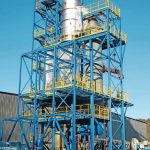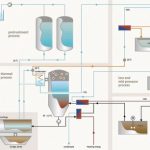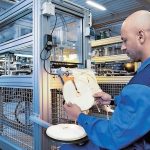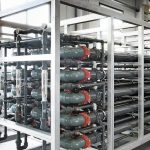Instead of discharging water which is as clean as possible, the aim in future is for production processes to discharge no water whatsoever. Together with its affiliate Membran Filtrations Technik (MFT), Hager + Elsässer has now developed the ZLD.eco2 process, which uses a series of novel filtration and separation technologies including three reverse osmosis stages and an innovative internal energy recycling system to reduce the subsequent evaporation of residual waste products to a minimum.
Production free of waste water
Reverse osmosis under high pressure
Instead of discharging water which is as clean as possible, the aim in future is for production processes to discharge no water whatsoever. Together with its affiliate Membran Filtrations Technik (MFT), Hager + Elsässer has now developed the ZLD.eco2 process, which uses a series of novel filtration and separation technologies including three reverse osmosis stages and an innovative internal energy recycling system to reduce the subsequent evaporation of residual waste products to a minimum.
The model for production totally free of waste water – zero liquid discharge (ZLD) – is increasingly being applied in a wide variety of industries. Around 400 ZLD plants are already in operation around the world. The underlying motives differ from region to region. For example, in areas of low rainfall such as the South of France the prime need is independence from the local water supply whereas in Germany ever more stringent environmental stipulations have been imposed, e. g. governing increases in salt loading. In regions such as the MENA countries or South America there are frequently no effluent treatment plants, so that ZLD acts in their stead. Companies in European countries which have an abundance of effluent treatment plants use ZLD for different reasons, namely for post-processing after the actual treatment process, e. g. in order to filter out antibiotic residues. ZLD is sometimes also employed to recover recyclable material or to improve the manufacturer’s image.
In the past, one impediment to discharge-free production has been the considerable investment and operating costs. The main problem has generally been the high energy requirement, which is why many companies have preferred to look for a site with ample supplies of water and improve their industrial water management rather than turn to discharge-free production. Hager + Elsässer has now teamed up with its associate MFT (Membran-Filtrations-Technik) to develop a new ZLD process which minimises the energy requirement by significantly shortening the evaporation stage: ZLD.eco². ZLD.eco² requires less space, is more efficient than other ZLD processes and demands about 20 % lower investment costs. Its optimised energy requirement makes ZLD.eco2 cost-efficient and particularly environmentally friendly.
Three membrane stages
At the heart of the system is a high pressure reverse osmosis stage. This involves a pre-treatment process, which can be chemico-physical or biological depending on the user, and an ultra-filtration stage to filter out residual organic material, followed by multi-stage membrane technology designed to concentrate non-organic waste material more densely. After the first two reverse osmosis stages entailing pressures of up to 80 bar, the residual concentrate contains around 20 % of the total waste water volume. This then passes through a third reverse osmosis stage, in which pressures of up to 200 bar are reached. This final stage uses a special module developed by MFT known as the CD (circular disc) module. Unlike in other modules utilising a meander flow pattern, the water takes a circular path through the CD module, which reduces pressure losses. Circular disc modules can be built and connected in series, so Hager+ Elsässer can use the same pump to provide four to five times as much membrane technology as other manufacturers.
Thermal energy fed back
The warm concentrate (approx. 70 °C) generated by the high pressure in the high pressure stage is then vaporised in the subsequent low pressure stage (evaporation stage), which interacts with the membrane technology to form a hybrid system and produce a manageable consistency. The thermal energy is fed back into the system and used to increase energy efficiency. This reduces the energy requirement of the system as a whole. The waste volume still present after the maximum pre-concentration produced by the high pressure membrane technology is lower than with conventional processes. As a result, the evaporation stage with ZLD.eco² can be considerably shorter. Since this concluding thermal stage is normally particularly costly, replacing it to a certain extent with reverse osmosis creates savings in terms of space and expense. The process ends with the evaporation of the residues. No waste water whatsoever remains.
Reduced chemical consumption
Compared to conventional systems without pre-concentration, ZLD.eco² requires about 20 % less energy. Also, since the evaporation plant is smaller, less cooling energy is needed for the condensation process. These savings can be as much as 80 %. Further economies can be achieved due to the modular design of the system. Hager + Elsässer prefabricates the modules, which cuts down the time needed for assembly; with conventional systems this can take up to three months. The savings in terms of staffing costs are around 20 % while the costs for commissioning are likewise down 20 %. Not least of the advantages is the reduced requirement for chemicals. An investment in ZLD.eco² pays for itself in only a short time because of the savings at different levels.
The customised system is also particularly robust. The membranes have a useful working life of about three to five years. They are available in a variety of different formats. In the low pressure stage of reverse osmosis, standard spiral reverse osmosis membranes are utilised as opposed to MFT circular disc modules in the high pressure stage. A touch screen control system is used to operate the ZLD.eco². This shows the technician real time data on all relevant parameters. Remote operation is a further option.
ZLD.eco² has already been installed at a steelworks in Byelorussia and will start operation next year. MFT also has a pilot plant to test wiring systems and improve the process still further. The first target markets for MFT are all countries with a significant crude oil industry, notably Colombia, Azerbaijan, Nigeria, Russia and China. The primary target industries are food, paper and pulp, chemicals, crude oil, gas, transportation and traffic systems as well as mining, which plays an important role in Canada and Chile.
www.cpp-net.com search: cpp0315hagerelsaesser
Oliver Rappich
Oliver Rappich
Director New Markets and Technologies, Hager + Elsässer
Share:










